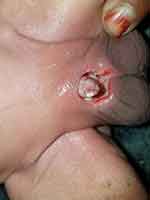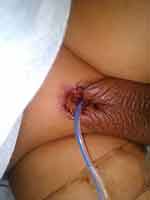Back to Journals » Research and Reports in Neonatology » Volume 10
Penile Injury During Ritual Circumcision
Authors Ahmed F , Al-Wageeh S , Al-Shami E , Al-Naggar K , Askarpour MR , Naji M
Received 27 September 2020
Accepted for publication 17 November 2020
Published 24 November 2020 Volume 2020:10 Pages 95—99
DOI https://doi.org/10.2147/RRN.S281896
Checked for plagiarism Yes
Review by Single anonymous peer review
Peer reviewer comments 3
Editor who approved publication: Dr Robert Schelonka
Faisal Ahmed,1 Saleh Al-Wageeh,2 Ebrahim Al-Shami,1 Khalil Al-Naggar,1 Mohammad Reza Askarpour,3 Mohammed Naji4
1Urology Research Center, Al-Thora General Hospital, Department of Urology, Ibb University of Medical Science, Ibb, Yemen; 2Department of General Surgery, Ibb University of Medical Science, Ibb, Yemen; 3Department of Urology, Shiraz University of Medical Sciences, Shiraz, Iran; 4Department of Urology, Dar Al-Shefa Hospital, Ibb, Yemen
Correspondence: Faisal Ahmed
Al-Thora General Hospital, Alodine Street, Ibb 70270, Yemen
Tel/Fax +967 4407128
Email [email protected]
Purpose: Circumcision is one of the most prevalently performed surgeries worldwide. It is a common non-therapeutic procedure, which, based on the cultural and social background of people, could be performed by individuals at different levels of skill ranging from trained medical professionals to non-specialists. Therefore, this surgery could cause complications of varying frequencies and types. For example, penile damage during the circumcision procedure is a severe and rare complication leaving patients with morbidity and life-long consequences. Here, we reported two cases of penile injury during a ritual circumcision.
Patients and Methods: This study was approved by the ethics committee of Ibb University of Medical Sciences.
Case 1: A 6-month-old child was brought to hospital by parents with complaints of purulent discharge around the penis after ritual circumcision performed 3 days ago with complete skin loss in the whole part of the penis extended to the scrotum and suprapubic area.
Case 2: A 2-month-old child was brought to hospital with complaints of penile discharge and gangrene after ritual circumcision performed 10 days ago.
Results: Case 1: He was treated with daily debridement and wound irrigation followed by a surgical procedure to bury the penis in the scrotum for future reconstructive surgery.
Case 2: A suprapubic cystostomy was inserted into the bladder. Then, daily debridement and wound irrigation was performed for the child. To treat penile gangrene, two options were available. The first option was to bury the penis in the scrotum and do reconstructive surgery later. The second option was to change the child’s anatomical sex from male to female.
Conclusion: We suggest that every child, before a circumcision procedure, should be evaluated by a medically trained professional. This procedure should also be carried out in aseptic conditions. Additionally, the circumcision procedure needs to be performed by an experienced medical professional.
Keywords: complications, penile injury, ritual circumcision
Plain Language Summary
Throughout the world, circumcision is the most prevalent procedure performed by various individuals at different knowledge and skill levels. This can, in turn, lead to severe complications. Penile damage during the circumcision procedure is a severe and rare complication leaving patients with morbidity and life-long consequences. In this paper, two cases of penile injury during ritual circumcision were reported. The first case’s penile injury was treated with daily debridement and wound irrigation followed by surgery in which the penis was buried in the scrotum for future reconstructive surgery. The second patient had two options. The first option was to bury the penis in the scrotum and do reconstructive surgery later. The second option was to change the infant’s anatomical sex from male to female. According to our observations, evaluation of every child by a medically trained professional is strongly suggested before undergoing a circumcision procedure, which is strongly recommended to be performed by an experienced medically trained person.
Introduction
Globally, circumcision is one of the most common surgical procedures conducted for non-therapeutic purposes. Medical indications for circumcision are phimosis happening secondary to balanitis xerotica obliterans and recurrent balanoposthitis. On the other hand, relative indications for circumcision are prevention of penile cancer, sexually transmitted infection, and urinary tract infection.1 Religious male circumcision was a cultural practice in South Africa and Yemen, which has raised severe health concerns.2 Depending on culture and religion of people, circumcision is performed by different individuals from trained health care practitioners to non-specialists. Different levels of knowledge and skill can lead to complications of various frequencies and types ranging from mild penile skin loss to severe lifelong complications, including glans, distal urethral, and penile shaft injuries. The complication rate of this surgery has been reported from 0.2 to 5%.3 This rate could vary on the basis of several factors, such as anatomical and medical comorbidities, surgical technique, the use of anesthesia, non-specialists individuals, and age.3 In this study, we described two cases of penile injury after ritual circumcision.
Patients and Methods
Case 1
A 6-month-old child was brought by parents complaining about discharge from the child’s penis after being undergone ritual circumcision using the Mogen clamp technique performed by a local unqualified traditional practitioner 3 days ago. No antibiotic was administered before the procedure. It had also been conducted without anesthetic. The patient’s vital sign was stable, with no previous history of trauma or urinary problems. The child’s physical examination showed a complete skin loss of penis extended to the scrotum and suprapubic area with purulent discharge around the penis (Figure 1).
 |
Figure 1 A complete skin loss in the whole penis extended to the scrotum with purulent discharge around the penis. |
Case 2
A 2-month-old child was brought with complaints of penile discharge and gangrene after ritual circumcision performed by an unqualified traditional practitioner using the Mogen clamp technique 10 days ago. The child had received neither an antibiotic nor an anesthetic drug before the procedure (Figures 2 and 3). We did not manage to conclude whether the hemostasis method or compressive dressing was responsible for glans gangrene.
 |
Figure 2 A complete skin loss after ritual circumcision. |
 |
Figure 3 A penile gangrene after ritual circumcision. |
Result
Case 1
The child was treated with daily debridement and wound irrigation followed by a surgical procedure to bury the penis in the scrotum for future reconstructive surgery. However, the patient’s parents refused any intervention due to financial problems and eventually the patient left the hospital without follow-up.
Case 2
Suprapubic cystostomy was inserted into the bladder. Then, daily debridement and wound irrigation was performed for the child. Another urologist also tried to release and resurface the trapped part of the penis with skin or buccal mucosa graft, but it was unsuccessful (Figure 4). Regarding the child’s penile gangrene treatment, looking forward, there were two available options Based on our experience. The first option was to bury the penis in the scrotum for future reconstructive surgery. The second option was to change the child’s anatomical sex from male to female (sex reassignment surgery).
 |
Figure 4 Failure to release and resurface the trapped part of penis with a skin. |
Discussion
Circumcision is one of the most common surgical procedures generally performed for three main reasons: mostly as a religious necessity, secondly as a prophylactic act in specific medical conditions, and thirdly when medically indicated.4
The circumcision-related complications could vary from wound infection to partial-to-total amputation of the penial body. They can have lifelong functional, sexual, psychological, and cosmetic consequences.5 Moreover, these complications could occur at a rate between 0.2 and 5%.3 In a study, out of 136 086 circumcised boys, the overall complication rate was 0.19%, while the rate of severe penile injuries was 0.025%.6 Other studies have reported higher complication rates (1.6%) with more severity, including death (in five cases) when unqualified village barbers had conducted the circumcision.7 Thus, we can claim that complication rates are much higher when the procedure is performed by non-specialists’ individuals.4,8 The most common acute complications in circumcision are bleeding, hematoma, urethral or glandular trauma, wound infection, and secondary phimosis.8 Moreover, penile or glandular amputation is the most severe but infrequent complication of circumcision.8 The level of this complication and the interval between injury and patient arrivals is essential for choosing the right treatment option.7 In Yemen, all boys are circumcised before puberty. Although many surgeons considered circumcision a minor procedure, to prevent catastrophic complications, documenting unusual outcomes such as those presented in this report seems necessary. This is especially crucial in countries such as Yemen, where unqualified traditional practitioners perform the majority of circumcisions, and consequently the procedure’s complications are often unreported and patients’ follow-up is mostly not feasible.4,8
Furthermore, in amputation cases, as a circumcision complication, it is essential to know the time, when this incident occurred, examine the patient to determine the extension of injury, and check the amputated tissues’ viability to decide on the best treatment. In their work, Sherman et al found that glandular tissue is viable up to 8 h after excision. They also claimed that dual blood supply to the glans penis and corpora spongiosum is an excellent vascularity source to the imposed graft or flap.9 However, in the present case, the patients referred to our center after 10 days, when the re-anastomosis was impossible. In amputation penile cases, preservation of the injured penis should be the first priority so that the penis should be rinsed with a normal saline solution, wrapped in saline-soaked gauze, and placed in a sealed sterile bag. The bag is then immersed in an ice slush bath while ensuring that the ice is not in direct contact with the penile skin since hypothermia has shown to prolong ischemic time and tissue survival.10
In another study, Belinky et al covered the exposed part of corpus cavernosum using distal urethra. However, to obtain the best outcome, a healthy urethra and long penile stump are needed.11 Mazza et al also used a tabularized fasciocutaneous scrotal flap to cover the exposed part of penis. Although showing good cosmetic results with some downside, such as higher expenses and high metal stenosis rate.12 Moreover, Palminteri suggested to use mucosa to reconstruct the distal parts of the cavernosum; however, this method tends to have contractures.13 In pediatric phalloplasty, there are also some controversies over the indication of age, size, and especially neophallic growth during puberty.2,5 Since normal genitalia is crucial for achieving favorable genital identity, especially during puberty, performing penis reconstruction in childhood is essential to minimize this surgery’s emotional impact.14
On the other side, glans necrosis may occur secondary to cautery use, compressive dressing, and some hemostasis methods, such as using vasoconstrictive agents. Hyperbaric oxygen, methylprednisolone, and pentoxifylline injection have been proved to be effective treatments for the patient with glanular skin necrosis.15,16
Considering the cases studied in this report, one of the patients was brought to our center 10 days after the incident; so, as mentioned earlier, we had missed the golden time to manage it with routine management. Generally, all forms of genital cutting performed on children (including unnecessary sex reduction circumcision surgery and sex-assignment/reassignment surgery) may have serious physical, sexual, and psychological consequences, which could be last for the rest of the patient’s life. Genital cutting imposed on normal, healthy children also causes grievous bodily harm (genital mutilation) and, in the absence of medical necessity, amounts to criminal sexual assault.17
Sex reassignment is even more difficult. Parents of all social and educational backgrounds almost always refuse this type of treatment for their male children. Many factors, including ethical and legal considerations are involved in sex reassignment so that an interdisciplinary team must be assembled to properly address the surgical, endocrinological, and psychosocial aspects of this problem. Moreover, long-term follow-up is an absolute necessity to evaluate the process of gender identification as well as the adequacy of surgically constructed genitalia. New knowledge evolving on the action of androgens on the fetal brain’s and penile growth may prove to be involved in the complex process of gender identity and role.2,18
Likewise, Ochoa reported seven children with amputated penis occurred during circumcision. He suggested phalloplasty using the remaining stumps of the corpora cavernosa as first-line therapy in children with the traumatic loss of penis since it could restore the organ’s functional and cosmetic aspects and make sex reassignment to the female gender unnecessary.18 However, in another study on four patients, who had a traumatic loss of penis, it was concluded that early feminizing genioplasty could be an excellent reconstructive method in the child with the traumatic loss of penis.19
The present study had some limitations, only two cases were reported in this study, and since they missed a follow-up appointment, we were unable to follow-up with patients. These imitations were not of great importance since our goal in this study was to report the hazardous consequences of ritual circumcision.
Conclusion
We strongly suggest that every male child, before being undergone a circumcision procedure, should be evaluated by a medically trained professional. This procedure is also suggested to be carried out in aseptic conditions by an experienced and medically trained person.
Consent
Written informed consent for publication of this case details, including the publication of the images, was obtained from the patient parents.
Funding
There is no funding to report.
Disclosure
The authors declare that they have no competing interest.
References
1. Malone P, Steinbrecher H. Medical aspects of male circumcision. BMJ. 2007;335(7631):1206–1290. doi:10.1136/bmj.39385.382708.AD
2. van der Merwe A, Graewe F, Zühlke A, et al. Penile allotransplantation for penis amputation following ritual circumcision: a case report with 24 months of follow-up. Lancet. 2017;390(10099):1038–1047. doi:10.1016/S0140-6736(17)31807-X
3. Pippi Salle JL, Jesus LE, Lorenzo AJ, et al. Glans amputation during routine neonatal circumcision: mechanism of injury and strategy for prevention. J Pediatr Urol. 2013;9(6):763–768. doi:10.1016/j.jpurol.2012.09.012
4. Atikeler MK, Onur R, Gecit I, Senol FA, Cobanoglu B. Increased morbidity after circumcision from a hidden complication. BJU Int. 2001;88(9):938–940. doi:10.1046/j.1464-4096.2001.02416.x
5. Martínez-Piñeiro L, Djakovic N, Plas E, et al. EAU guidelines on urethral trauma. Eur Urol. 2010;57(5):791–803. doi:10.1016/j.eururo.2010.01.013
6. Wiswell TE, Geschke DW. Risks from circumcision during the first month of life compared with those for uncircumcised boys. Pediatrics. 1989;83:1011–1015.
7. Rizvi SA, Naqvi SA, Hussain M, Hasan AS. Religious circumcision: a muslim view. BJU Int. 2002;83(Suppl S1):13–16. doi:10.1046/j.1464-410x.1999.0830s1013.x
8. Tiwari S, Deshmukh S, Kekre G, Dikshit V, Kothari P. Traumatic penile injury with successful glans reimplantation: a case report. Pediatr Urol Case Rep. 2020;7(2):52–55. doi:10.14534/j-pucr.2020258450
9. Raisin G, Kocherov S, Jaber J, Shenfeld O, Hardak B, Chertin B. Glans injury during ritual circumcision. J Pediatr Urol. 2020;16(4):
10. Jezior JR, Brady JD, Schlossberg SM. Management of penile amputation injuries. World J Surg. 2001;25(12):1602–1609. doi:10.1007/s00268-001-0157-6
11. Belinky JJ, Cheliz GM, Graziano CA, Rey HM. Glanuloplasty with urethral flap after partial penectomy. J Urol. 2011;185(1):204–206. doi:10.1016/j.juro.2010.09.010
12. Mazza ON, Cheliz GM. Glanuloplasty with scrotal flap for partial penectomy. J Urol. 2001;166(3):887–889. doi:10.1016/S0022-5347(05)65857-0
13. Palminteri E, Berdondini E, Lazzeri M, Mirri F, Barbagli G. Resurfacing and reconstruction of the glans penis. Eur Urol. 2007;52(3):893–898. doi:10.1016/j.eururo.2007.01.047
14. Djordjevic ML, Bumbasirevic MZ, Vukovic PM, Sansalone S, Perovic SV. Musculocutaneous latissimus dorsi free transfer flap for total phalloplasty in children. J Pediatr Urol. 2006;2(4):333–339. doi:10.1016/j.jpurol.2006.05.003
15. Aslan A, Karagüzel G, Melikoglu M. Severe ischemia of the glans penis following circumcision: a successful treatment via pentoxifylline. Int J Urol. 2005;12(7):705–707. doi:10.1111/j.1442-2042.2005.01129.x
16. Migliorini F, Bianconi F, Bizzotto L, Porcaro AB, Artibani W. Acute ischemia of the glans penis after circumcision treated with hyperbaric therapy and pentoxifylline: case report and revision of the literature. Urol Int. 2018;100(3):361–363. doi:10.1159/000444399
17. Boyle GJ. Ending the Forced Genital Cutting of Children and the Violation of their Human Rights. In: G.C.Deeniston,F.M. Hodges,and M.F. Milos (Eds.), Understanding Circumcision: A multi-disciplinary approch to a multi-dimensional problem.Springer; 2001:1–18.
18. Ochoa B. Trauma of the external genitalia in children: amputation of the penis and emasculation. J Urol. 1998;160(3 Part 2):
19. Gearhart JP, Rock JA. Total ablation of the penis after circumcision with electrocautery: a method of management and long-term followup. J Urol. 1989;142(3):799–801. doi:10.1016/S0022-5347(17)38893-6
 © 2020 The Author(s). This work is published and licensed by Dove Medical Press Limited. The full terms of this license are available at https://www.dovepress.com/terms.php and incorporate the Creative Commons Attribution - Non Commercial (unported, v3.0) License.
By accessing the work you hereby accept the Terms. Non-commercial uses of the work are permitted without any further permission from Dove Medical Press Limited, provided the work is properly attributed. For permission for commercial use of this work, please see paragraphs 4.2 and 5 of our Terms.
© 2020 The Author(s). This work is published and licensed by Dove Medical Press Limited. The full terms of this license are available at https://www.dovepress.com/terms.php and incorporate the Creative Commons Attribution - Non Commercial (unported, v3.0) License.
By accessing the work you hereby accept the Terms. Non-commercial uses of the work are permitted without any further permission from Dove Medical Press Limited, provided the work is properly attributed. For permission for commercial use of this work, please see paragraphs 4.2 and 5 of our Terms.
